



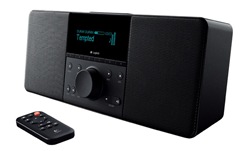
Adding to their Squeezebox line-up, Logitech has recently released their Squeezebox Boom. It uses the same technology as the
Squeezebox Duet, in fact it can be controlled from the same remote and be a part of a system. Not entirely unlike the
Sonos players that also come in a line-out unamplified version and one with a 50W power stage. The Squeezebox Boom just adds a pair of built-in speakers to make it an autonomous unit.
With specs like its sister device, sound quality is only limited to the quality of the amplifier and the miniscule speakers which, incidentally, sound incredibly good for their size. There is a 7-day alarm clock [with a built-in snooze button, no less] and automatic dimming of the display, making this perfect for a bedroom setup.
First impressions are that of a solid device. It is heavy and feels rather rugged in its rubbery front panel covering and shiny cabinet. Buttons operate smoothly and the remote, however small, feels good even in large hands and has quite a good reach. The display may seem old fashioned but the fact is that this type of Nixie-look-a-like display works very well in a dimly lit room, where color LCDs have a tendency to be overly bright. In addition to the ever present Squeezebox controls, the front panel offers 6 preset buttons that can be programmed directly from the device or from a Squeezebox Server using the KidsPlay plugin. Using this plugin gives you an almost unbelievable amount of programming options, such as (but all but limited to) choosing a random mix of tracks of a given genre while showing a brief message on the display as to which genre that is while clearing previous playlist selections. Nice, eh? In fact, it is difficult not to fiddle.
Should you need to, the Squeezebox Boom can be mounted in several positions with an optional L-bracket.
![]()
![]()
![]()
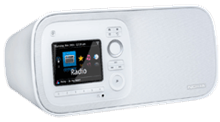 Sporting a wifi connection, wired ethernet and FM reception, this internet radio is very much that; an internet radio. A slick design centered around a pretty colour display and cool navigation controls paired with uPNP support and self sufficiency makes this a very attractive kitchen music piece, in so far that kitchen can mean just about any room in the house not equipped with a stereo system. It is yet unclear which media formats are supported.
Sporting a wifi connection, wired ethernet and FM reception, this internet radio is very much that; an internet radio. A slick design centered around a pretty colour display and cool navigation controls paired with uPNP support and self sufficiency makes this a very attractive kitchen music piece, in so far that kitchen can mean just about any room in the house not equipped with a stereo system. It is yet unclear which media formats are supported.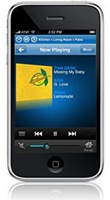 I mentioned the
I mentioned the 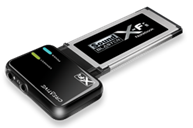 Frankly this gadget was hard to fit into this blog but somehow it needs to be here. It is actually two devices. The X-Fi Notebook is a PCCARD soundcard with built-in wireless transmission using the other part of the equation; the Creative Wireless Receiver.
Frankly this gadget was hard to fit into this blog but somehow it needs to be here. It is actually two devices. The X-Fi Notebook is a PCCARD soundcard with built-in wireless transmission using the other part of the equation; the Creative Wireless Receiver.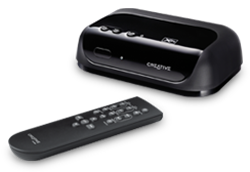 With the receiver it should be possible to transmit music to 4 discrete zones, each equipped with one. In other words: With a decent notebook, an X-Fi Notebook and sufficient receivers, you could build a multi-zone streamer fairly easily. The soundcard itself supports resolutions up to 24bit/48KHz and works pretty much as any other soundcard.
With the receiver it should be possible to transmit music to 4 discrete zones, each equipped with one. In other words: With a decent notebook, an X-Fi Notebook and sufficient receivers, you could build a multi-zone streamer fairly easily. The soundcard itself supports resolutions up to 24bit/48KHz and works pretty much as any other soundcard. Adding to their Squeezebox line-up, Logitech has recently released their Squeezebox Boom. It uses the same technology as the
Adding to their Squeezebox line-up, Logitech has recently released their Squeezebox Boom. It uses the same technology as the 
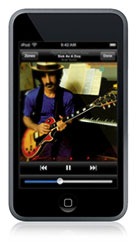 Those who own both a
Those who own both a  The Avoca VIP Music Edition sports some pretty nice specs in a pretty case accompanied by a slightly less pretty PDA based controller. The media center rips CDs to
The Avoca VIP Music Edition sports some pretty nice specs in a pretty case accompanied by a slightly less pretty PDA based controller. The media center rips CDs to 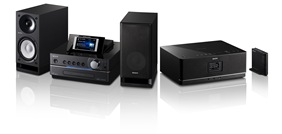 This is a complete system with zone system serving up to 5 rooms, ripping from CD and lossless streaming [
This is a complete system with zone system serving up to 5 rooms, ripping from CD and lossless streaming [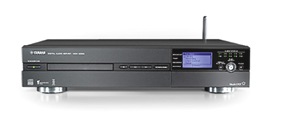 Like a bunch of other devices here, the Yamaha MCX-2000 offers CD ripping, storing and streaming. A total of 16 playback clients, including the server, is supported, letting you access music from its 160GB upgradable harddisk from just about every conceivable location. While it does not appear to support
Like a bunch of other devices here, the Yamaha MCX-2000 offers CD ripping, storing and streaming. A total of 16 playback clients, including the server, is supported, letting you access music from its 160GB upgradable harddisk from just about every conceivable location. While it does not appear to support 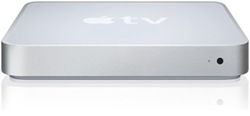 It just occurred to me that I had forgotten one of the major players in the field of digital media – Apple. Last year they canonballed their Apple TV into the arena and it really does deserve a mention.
It just occurred to me that I had forgotten one of the major players in the field of digital media – Apple. Last year they canonballed their Apple TV into the arena and it really does deserve a mention.